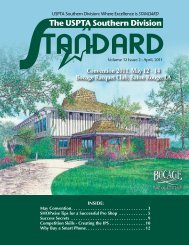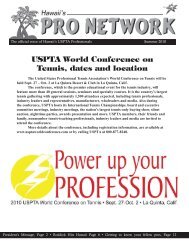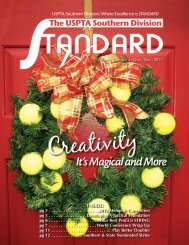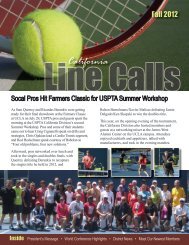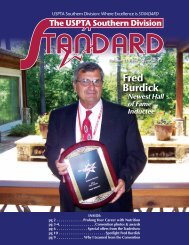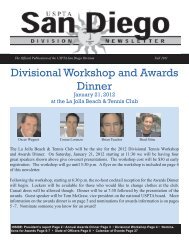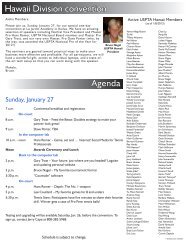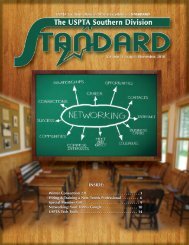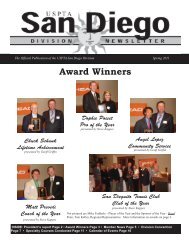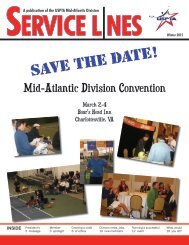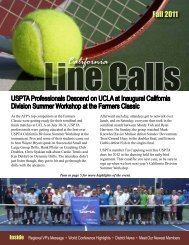Newsletter - USPTA divisions - United States Professional Tennis ...
Newsletter - USPTA divisions - United States Professional Tennis ...
Newsletter - USPTA divisions - United States Professional Tennis ...
Create successful ePaper yourself
Turn your PDF publications into a flip-book with our unique Google optimized e-Paper software.
A publication of the <strong>USPTA</strong> Mid-Atlantic Division<br />
SERVICE L NES<br />
Scenes from Monterey<br />
INSIDE<br />
President’s<br />
2 message<br />
Member<br />
3 spotlight<br />
Slide or<br />
6 Stride<br />
World Conference<br />
10 wrapup<br />
Metabolism<br />
12<br />
Fall 2012<br />
and the <strong>USPTA</strong> World Conference<br />
Clockwise from left: Joni Hannah, Sinikka English and Jim<br />
Fromuth; Pat Hanssen and John Cleary; James Ridgley shows<br />
off his winning bid at the silent auction; Donald Widener and<br />
Jill Phipps; Hans Romer and Feisal Hassan.<br />
Evaluate your<br />
16 tennis programs<br />
New members<br />
18
Service Lines<br />
2<br />
Mid-Atlantic Division<br />
John Cleary<br />
President<br />
Mid-Atlantic Division<br />
Board of Directors<br />
President<br />
John Cleary 301-340-6185<br />
First/regional vice president<br />
Carl Clark 804-287-1300<br />
Vice president<br />
Joni Hannah 703-938-5510<br />
Treasurer<br />
JD Almond 703-501-1773<br />
Secretary<br />
Terence Killen 703-938-5510<br />
Past president<br />
Pat Hanssen 434-295-6167<br />
District presidents<br />
Virginia<br />
Jason Grigg 434-978-7529<br />
West Virginia<br />
TBA<br />
District of Columbia<br />
TBA<br />
Maryland<br />
Ron Shelton 443-629-4562<br />
Head tester<br />
Ted Meyer 301-865-2701<br />
Women's liaison<br />
Sue E. Nidzgorski 703-803-8483<br />
Convention coordinator<br />
Patrick Kearns 434-531-8876<br />
Executive administrator<br />
Jill Phipps 888-877-8232<br />
message from your<br />
President<br />
Fellow <strong>USPTA</strong> <strong>Professional</strong>s,<br />
I hope everyone is having a great fall with your indoor seasons now in full swing. The<br />
past year has certainly been an exciting and eventful time for the <strong>USPTA</strong> and tennis in<br />
general.<br />
With the retirement of longtime CEO Tim Heckler and the hiring of John Embree, I am<br />
confident that everyone in our association will work together in order to make the <strong>USPTA</strong><br />
stronger than ever. I urge all of you to get involved at the local level by working with<br />
one of our various committees, or by simply submitting an article for publication in this<br />
newsletter.<br />
If you were not able to attend the World Conference in Monterey, Calif., this year, you<br />
certainly missed out on some great educational and networking opportunities. I was fortunate<br />
to attend seminars presented by some of our industry’s most knowledgeable people<br />
such as Jim Loehr, Vic Braden, Nick Bollettieri and Jose Higueras, to name a few. One<br />
of the most valuable sessions I attended was the General Membership update hosted by<br />
our national president Tom Daglis. There, members from around the country were able to<br />
interact with our national board by asking questions and making suggestions to those who<br />
are the decision makers for our organization. A lot of great ideas were exchanged and we<br />
hope to incorporate a similar session into our spring convention which will be held March<br />
1-3, 2013, at the Boar’s Head Inn in Charlottesville, Va.<br />
Two of the most important issues that were discussed at our annual meeting were our<br />
association’s declining membership numbers and our current endorsement contracts. It<br />
is incumbent upon all of us to keep our memberships active and to encourage our fellow<br />
professionals who are not members to take advantage of all the <strong>USPTA</strong> has to offer. Our<br />
association needs a steady stream of membership dollars in order to provide the quality<br />
service we are accustomed to. Among the most valuable benefits the <strong>USPTA</strong> offers to its<br />
members are free or discounted products provided by companies such as HEAD Penn,<br />
Fromuth, Dartfish, CourtsideUSA, Aer-Flo, SportMaster and 10-S Supply. It is important<br />
that we support all of our endorsees and continue to spread the word about their products<br />
so in turn, they will be there for us in the future. Contact your local sales representative<br />
today and let them know you appreciate their support. This will go a long way in making<br />
our professional relationships stronger and continuing them for years to come.<br />
Finally, I would like to extend congratulations to <strong>USPTA</strong> Mid-Atlantic member Feisal<br />
Hassan for earning the award for George Bacso National <strong>USPTA</strong> Tester of the Year. Feisal<br />
is a fixture at conventions nationwide and anyone who has heard him speak has undoubtedly<br />
come away with some valuable information. Some of Feisal’s previous accolades<br />
include the <strong>USPTA</strong> Industry Excellence Award in 1999, the <strong>Tennis</strong> Industry’s 40 Under<br />
40 in 2000, five-time Division Tester of the Year, 10-time <strong>USPTA</strong> Division/State Pro of<br />
the Year, and seven-time national Top-10 point holder in the <strong>USPTA</strong>’s Career Development<br />
Program. Way to go Feisal, we’re fortunate to have you as part of our division!<br />
Warm regards,<br />
John Cleary, <strong>USPTA</strong><br />
President, <strong>USPTA</strong> Mid-Atlantic Division
Member Spotlight<br />
Mark O’Bryan<br />
Mark O’Bryan is the assistant tennis<br />
professional at Lakewood Country<br />
Club in Rockville, Md. He previously<br />
worked at the Polo Golf and Country<br />
Club in Georgia and Quince Orchard<br />
Swim and <strong>Tennis</strong> Club in Maryland, as<br />
well as the Saddlebrook <strong>Tennis</strong> Academy and Chevy Chase<br />
Country Club. Mark played on the Alma College tennis<br />
team before completing his marketing/professional tennis<br />
management degree at Ferris State University.<br />
Q: Where did you learn to play tennis?<br />
A: I grew up in a tennis family and started playing<br />
with my dad when I was young. He was a high<br />
school coach in Michigan and ran summer camps<br />
in our community, and that is where I really fell in<br />
love with the game.<br />
Q: Where did you play your college tennis? What<br />
were some of your playing highlights?<br />
A: I played at Alma College, a D3 school in Michigan.<br />
One of the best memories of playing for the<br />
Scots was earning the MIAA Tournament MVP, as<br />
well as having the opportunity to travel with my<br />
team on several spring break trips to play schools<br />
down south.<br />
Q: What do you enjoy most about being a tennis<br />
professional?<br />
A: The thing I enjoy most about my job is being able<br />
to teach all different levels and age groups, and to<br />
see my students make steady progress. The most<br />
fulfilling thing for me is to see a student really<br />
take ownership of their game, and how excited<br />
they get when they learn something new.<br />
Q: Why would you recommend that other tennis<br />
professionals become <strong>USPTA</strong> members?<br />
By John Cleary<br />
A: I think the conferences and continuing education<br />
opportunities are invaluable for a teaching professional,<br />
as well as the chance to network and meet<br />
other professionals in the industry. Additionally,<br />
The Job Board has always been a great resource<br />
for me when looking for new employment opportunities.<br />
Q: How would you describe your teaching style/<br />
philosophy?<br />
A: I have always enjoyed the technical aspects of<br />
teaching a stroke, and I really enjoy helping students<br />
make adjustments to stroke mechanics, but<br />
I try to teach in a live-point environment as much<br />
as possible. I try to make my lessons high-energy<br />
and fun, and hopefully my students learn a little<br />
something as well!<br />
Q: If you were not a tennis professional, what would<br />
your occupation be?<br />
A: If I weren’t a tennis professional, I would most<br />
likely have gone into secondary education with a<br />
focus in history. I really enjoy teaching, and both<br />
of my parents worked as educators, so I have<br />
always felt at home in that environment.<br />
Q: What are your off-court hobbies/interests?<br />
A: When not on the court, my fiancee, Katy, and I<br />
like to go hiking and biking, and we always love<br />
trying new restaurants.<br />
Q: Three people you would most like to have lunch<br />
with.<br />
A: Chris Farley, John Belushi and Bo Schembechler.<br />
Service Lines Mid-Atlantic Division<br />
3
Service Lines<br />
The annual Citi Open Kids’ Day took<br />
place on July 28th, at the William<br />
4<br />
H.G. Fitzgerald Center in Rock<br />
Creek Park. The three-hour event<br />
(directed by Chris Tran), was open to<br />
all youth under 17 years of age. This<br />
year’s event attracted approximately<br />
150 youth throughout the Mid-Atlantic<br />
region including Washington D.C.,<br />
Maryland, and Northern Virginia. There<br />
were 14 volunteers who made the Kids’<br />
Day engaging and fun. Included in our<br />
volunteer group were Mid-Atlantic<br />
Second VP Joni Hannah, Mid-Atlantic<br />
Secretary Terence Killen, Alexandra<br />
Gaspar, Nebyu Retta and Mani Barajas-<br />
Alexander.<br />
Mid-Atlantic Division<br />
Citi Open Kids’ Day<br />
By Chris Tran
2013 <strong>USPTA</strong> Mid-Atlantic <strong>Tennis</strong> Hall<br />
of Fame nominations<br />
With our March convention just around the corner, this<br />
is a great time to nominate your fellow teaching professional<br />
for the 2013 <strong>USPTA</strong> Mid-Atlantic Hall of Fame.<br />
Last year our inaugural class included Rod Dulany, Feisal<br />
Hassan, Kim Dillard and Terry Killen. There are many that<br />
do so much for our division. Let’s show our support and<br />
recognition for those that have been mentors for us in the<br />
industry.<br />
The Hall of Fame inductee(s) will be honored at the<br />
Mid-Atlantic convention in March. In addition to a plaque,<br />
the inductee(s) will also have their personal bios and pictures<br />
posted on the divisional website for all to see. Here is<br />
a list of some qualifications that are required to be eligible<br />
for the award:<br />
1. A current or past member of the <strong>USPTA</strong> who has recorded<br />
20 years or more of service.<br />
2. A candidate must have lived and worked within the<br />
Mid-Atlantic Division for no less than 15 years of<br />
membership to the <strong>USPTA</strong> to be considered for nomination.<br />
3. A record of service to the tennis industry that would be<br />
deemed outstanding enough to be selected by the Hall of<br />
Fame Committee. Contributions made while living in the<br />
Mid-Atlantic Division are weighed more heavily than<br />
contributions made while living outside of the Division.<br />
Criteria could include the following: Master <strong>Professional</strong>,<br />
president of division, National Executive Board<br />
Member, or made a dramatic impact in the teaching profession<br />
through articles, videos, or community service.<br />
If you are interested in nominating yourself or someone<br />
else please fill out the Mid-Atlantic Hall of Fame application<br />
and email back to tkillen@westwoodcc.com. The Hall<br />
of Fame committee will review all applications and make<br />
their decisions before the division convention in March.<br />
<strong>USPTA</strong>/Mid-Atlantic Division Hall of Fame nomination form<br />
Name: ___________________________________________________________________________________________<br />
Address: _________________________________________________________________________________________<br />
Phone No.: _____________________ Office No. _______________________ Cell No. ________________<br />
<strong>USPTA</strong> No.: ____________________ Year joined: _____________________ Years member ___________<br />
Please use additional space to complete the following:<br />
<strong>Tennis</strong> employment history: __________________________________________________________________________<br />
Service to the <strong>USPTA</strong> (State, Division & National): _______________________________________________________<br />
Teaching/coaching accomplishments:___________________________________________________________________<br />
Playing skills/rankings: ______________________________________________________________________________<br />
Service to allied associations: _________________________________________________________________________<br />
Publications/presentations/innovations: _________________________________________________________________<br />
Awards and honors: _________________________________________________________________________________<br />
Additional comments: _______________________________________________________________________________<br />
Nominated by: ____________________________________________________________________________________<br />
Service Lines Mid-Atlantic Division<br />
5
Service Lines<br />
6<br />
Mid-Atlantic Division<br />
SLIDE or STRIDE:<br />
A hole in my shoe<br />
This tennis playing podiatrist logged many hours<br />
on the court during the summer. Playing in Mid-<br />
Atlantic, national and international competition,<br />
my feet took a beating. Recently, I happened to<br />
feel a “breeze” on the bottom of my right shoe and noticed<br />
a large hole (Figure 1). Although this self-inflicted “air<br />
conditioning system” might be helpful on those hot and<br />
humid summer days, it is NOT recommended for any tennis<br />
player. Nonetheless, this hole in my sole offered me “food<br />
for thought.”<br />
Over the last several years, I have noticed more and<br />
more professional tennis players sliding on hard courts (in<br />
addition to the common practice of sliding on clay courts).<br />
Maybe, as I yearn to elevate my game, this has been my<br />
missing ingredient to greater success. Having been raised<br />
on the public hard courts of Terre Haute, Ind., I must admit<br />
that I was never instructed on the proper technique of sliding<br />
on a tennis court. But perhaps, the first step in mastering<br />
this technique is to purchase a new pair of shoes that<br />
will assist me in sliding. As Spike Lee/“Mars Blackmon”<br />
said in 1989 on the famous Michael Jordan commercials,<br />
“It’s gotta be the shoes, money.” Therefore, as a reasonably<br />
well-informed consumer, I began my search.<br />
In purchasing a tennis shoe, the portion of the shoe that<br />
most directly affects one’s ability to slide or not to slide is<br />
the outer sole of the shoe (Figure 2). And, there are several<br />
features that need to be considered. First of all, the tread on<br />
the sole that is most necessary for sliding is the characteristic<br />
herringbone pattern. These shoes can be utilized on clay<br />
because this pattern allows for sliding with the necessary<br />
traction. For players that desire to play on hard courts, a<br />
modified herringbone pattern is utilized. A second important<br />
factor to consider is the density of the rubber that is<br />
used on the outersole. That is, a shoe with a harder density<br />
rubber should be used on a hard court. On the other hand,<br />
playing on a clay court would be better in a shoe with a less<br />
dense rubber.<br />
From my perspective, if Andy Roddick, Novak<br />
Djokovic, Rafael Nadal, James Blake, Kim Clijsters, etc.,<br />
can slide on a hard court, why can’t Dr. Alex Kor (or any<br />
Mid-Atlantic tennis player) emulate today’s stars? If one<br />
examines this list of “today’s best hard court sliders” on<br />
tour and the brand of shoe that they use, it is interesting to<br />
By Alex Kor, DPM, MS<br />
Johns Hopkins Bayview Medical<br />
Baltimore, Md.<br />
note that there does not<br />
seem to be one brand<br />
name that is superior.<br />
Therefore, it comes as<br />
no surprise that there<br />
is NOT a significant<br />
difference in philosophies<br />
among a few of<br />
the shoe companies that<br />
I contacted with regard<br />
to sliding. Terry Gibson,<br />
assistant marketing<br />
manager for Wilson<br />
Sporting Goods, states<br />
that the Wilson tennis<br />
shoes use a directional<br />
herringbone pattern Figure 1<br />
in combination with a<br />
high density, extremely durable rubber compound (Duralast<br />
Supreme) for abrasion resistance on hard courts. Nike does<br />
not make a shoe specifically for sliding on a hard court,<br />
because “the outsole would wear out more quickly.” Monte<br />
Long (the Mid-Atlantic sales representative from Babolat)<br />
tells me that Babolat has introduced the Optimized Cell<br />
System (OCS) which includes small circles which open up<br />
when the shoe is placed in a lateral position which creates<br />
more traction. In addition, he also explained that a sole with<br />
a harder rubber will slide better on a firm, smooth hard surface,<br />
whereas a softer material will grip better, but not last<br />
as long.<br />
Thus, as you can see, my “shopping trip” was NOT so<br />
straight-forward. Maybe Spike Lee/“Mars Blackmon” was<br />
wrong in 1989, and I need to improve my technique. There<br />
is no doubt that the practice of sliding on a clay court is<br />
well-established and somewhat innate for players who are<br />
raised on the “kitty litter.” That is, according to Baltimore<br />
teaching pro and former ATP touring pro, Steve Krulevitz,<br />
“Sliding on clay is an art. And yet, it must be practiced.<br />
Fellow pros on the tour, especially from Australia and New<br />
Zealand, used to practice doing sliding drills.” Maybe I<br />
need to begin these drills now. In my zest to improve, I re-
quested input from Jack Schore, a Washington, D.C., based<br />
tennis pro who coached Dan Goldie and Richey Reneberg.<br />
Jack told me, “When sliding on clay, your objective is to<br />
slide into the shot. Some players think that you slide after<br />
the shot, but this is incorrect.” Phil Flanagan, a <strong>USPTA</strong><br />
teaching pro in Boca Raton, Fla., adds that, “Sliding after<br />
the contact point creates a more difficult recovery because<br />
of the extra time and distance the player is moving away<br />
from the center of the court.” On the other hand, when<br />
properly executed, Flanagan states that, “At the contact<br />
point, the player has a solid base from which to power up<br />
and through the ball. After contact, the player is able to<br />
push off to recover before the next shot.”<br />
According to data from “From Breakpoint to Advantage,”<br />
by Dr. Babette Pluim and Dr. Marc Safran, it is clear<br />
that sliding on a clay court results in less wear and tear on<br />
the body versus the same activity on a hard court. Thus,<br />
it comes as no surprise to me that Jack Schore does not<br />
advocate sliding on a hard court. Jack says, “The court does<br />
not give like clay and there is a chance of your ankle twisting<br />
each time you attempt a slide.” Thus, as a podiatrist, I<br />
would caution the recreational or novice player who desires<br />
to begin sliding on a hard court for fear that he/she may<br />
sustain an acute ankle sprain, ankle or foot fracture, blisters,<br />
and overuse conditions.<br />
Phil Flanagan agrees with Jack in not suggesting his<br />
students slide on a hard court. But, he adds that “The<br />
hard-court sliding that<br />
you see on television<br />
is being performed by<br />
world-class athletes<br />
who posses the physical<br />
skills and strength<br />
that allow them to<br />
slide. The physical<br />
demands of the professional<br />
game sometimes Figure 2<br />
require that the player<br />
slide while running wide. However, you will also notice<br />
that the hard court slide usually occurs after the contact<br />
point.”<br />
A tennis player’s ability to slide on a court can be<br />
affected by age, athletic ability, flexibility, weight, court<br />
surface and the outer sole of the shoe. In reviewing these<br />
expert opinions that I have gathered, I have concluded that<br />
I may be doing more harm than good in trying to slide on a<br />
hard court. Therefore, like many Mid-Atlantic tennis players,<br />
I may simply need to play more and practice harder.<br />
Perhaps Bruce Lipka, director of tennis at Woodmont<br />
Country Club, sums it up best by saying, “The only thing<br />
affecting your ability to slide is your ability to slide.” Well,<br />
I have been known to do the “electric slide,” but I may<br />
want to restrict this to the dance floor.<br />
Service Lines Mid-Atlantic Division<br />
7
Service Lines<br />
8<br />
Mid-Atlantic Division<br />
News from National<br />
New <strong>USPTA</strong> CEO/<br />
Executive Director –<br />
John Embree<br />
The <strong>USPTA</strong> Board of Directors<br />
and Search Committee has hired<br />
industry veteran John Embree as<br />
the new CEO/Executive Director.<br />
Embree will take the administrative<br />
reigns from Tim Heckler, who will retire at the end of the<br />
year, after 30 years in the position. Embree will begin transitioning<br />
into his role as of October 1 and will be relocating<br />
to the national office in Houston on November 1.<br />
The association conducted a search for the new CEO/<br />
Executive Director, and after interviewing several candidates<br />
in conjunction with the executive search firm, GSI<br />
Executive Search Inc., the <strong>USPTA</strong> Search Committee offered<br />
the position to Embree. The contract was ratified by<br />
the <strong>USPTA</strong> Executive Committee in late August.<br />
“I began my tennis odyssey during college as a teaching<br />
professional in Virginia. After more than three decades<br />
of working in the sport that I began playing at 6 years old,<br />
my career has come full circle, back to my foundation as a<br />
grassroots advocate. I am thrilled to have been chosen by<br />
the Executive Committee to help lead the <strong>USPTA</strong> in the<br />
years to come,” said Embree.<br />
“We are pleased to welcome John Embree into the<br />
<strong>USPTA</strong> family. His vast tennis industry expertise, contacts,<br />
and company management skills will serve the <strong>USPTA</strong><br />
well,” said President Tom Daglis.<br />
Embree has held many influential industry roles for<br />
more than 30 years. They include serving as President of<br />
Prince Sports, The Americas; President of Balle de Match<br />
LLC; and Vice President/General Manager, Racquet Sports<br />
Division for Wilson Sporting Goods Co. Most recently,<br />
he launched a tennis consulting practice to assist endemic<br />
brands, associations and new corporate entities in maximizing<br />
their impact in the tennis marketplace. His client list<br />
included the USTA, ITA, Peter Burwash International, Off<br />
the Grid Technologies, and Donnay USA.<br />
Playtennis.com<br />
Playtennis.com is the new USTA/TIA-sponsored<br />
industry website for players. It is a portal for tennis players<br />
with a social media component. It will allow players to<br />
search for teaching professionals, facilities, programs, and<br />
partners. As a tennis-teaching professional,<br />
this new industry website allows<br />
you to interact and connect with the<br />
vast market of players. It gives players<br />
the opportunity to find you, your facility<br />
and your programs. The tennis public<br />
can rate their experiences at a facility or<br />
with a tennis-teaching pro and provide comments and feedback.<br />
This site is looking to provide information to players/<br />
consumers on active tennis-teaching professionals.<br />
Teaching professionals who are currently teaching the<br />
general public, who are looking to grow their lesson base,<br />
and whose facilities allow them to teach nonmembers will<br />
benefit by enrolling with Playtennis.com.<br />
If you qualify as an active tennis-teaching pro and want<br />
to participate, you may provide your facility’s information<br />
to Playtennis.com.<br />
• Register and create your searchable profile<br />
• Determine how much information to provide on yourself,<br />
your facility and your programs<br />
• Decide if you want to enable consumers to rate you and<br />
your programs, and provide comments<br />
• Update your contact information as necessary<br />
• Decide to opt out at any time (at which time you will be<br />
able to deactivate your profile)<br />
Please keep in mind the information collected during registration<br />
will be collected on playtennis.com (not on <strong>USPTA</strong>.<br />
com or any of <strong>USPTA</strong>’s websites), so any information you<br />
provide will be given directly to playtennis.com. Register<br />
Today.<br />
<strong>USPTA</strong> raises more than $7, 500 during<br />
Lessons for Life silent auction<br />
The <strong>United</strong> <strong>States</strong> <strong>Professional</strong> <strong>Tennis</strong> Association<br />
raised $7,582 from its silent auction held at the <strong>USPTA</strong>’s<br />
<strong>Tennis</strong> Buying Show during the World Conference on <strong>Tennis</strong><br />
from Sept. 16-21, at the Hyatt Regency Monterey Hotel<br />
& Spa in Monterey, Calif.<br />
During the silent auction, attendees had an opportunity<br />
to bid on a variety of items, including:<br />
• Maria Sharapova-autographed racquet, courtesy of<br />
HEAD/Penn<br />
• 6-ft by 10-ft. Tuffy windscreen panel with a 3-ft by 3-ft<br />
one-color logo, courtesy of Aer-Flo
• Dartfish Connect 6.0, courtesy of Dartfish<br />
• Two tickets to the 2013 U.S. Open, courtesy of USTA<br />
• Nike shoes for a year, one per quarter, courtesy of<br />
Fromuth<br />
• Two-night stay at Hyatt Regency Monterey Hotel &<br />
Spa, Monterey, Calif., courtesy of Hyatt Regency Monterey<br />
The auction benefits the <strong>USPTA</strong> foundation, which<br />
through grants supports various programs in the community<br />
that help to grow tennis and bring the game to those who<br />
might not otherwise have the chance to play. Thanks to<br />
everyone who has helped make the silent auction a success<br />
through their generous donations.<br />
Doris Hart and Francisco “Pancho”<br />
Segura inducted into <strong>USPTA</strong>’s Hall of<br />
Fame<br />
Doris Hart and Francisco “Pancho” Segura were<br />
inducted into the <strong>USPTA</strong> Hall of Fame during its annual<br />
awards breakfast, Sept. 19 at the <strong>USPTA</strong> World Conference<br />
on <strong>Tennis</strong> held at the Hyatt Regency Monterey Hotel & Spa<br />
in Monterey, Calif. Hart, who resides in Coral Gables, Fla.,<br />
has been a <strong>USPTA</strong> Pro 1 since 1955. Segura, who resides in<br />
Carlsbad, Calif., has been a <strong>USPTA</strong> Pro 1 since 1946. Both<br />
join only 11 others as grand inductees in the <strong>USPTA</strong> Hall of<br />
Fame.<br />
Doris Hart was born June 20, 1925,<br />
in St. Louis, Mo. She won 35 Grand<br />
Slam titles during her career. Six of<br />
her titles were in women’s singles, 14<br />
in women’s doubles, and 15 in mixed<br />
doubles.<br />
Hart is one of three players, all<br />
women, to have a “boxed set” of<br />
Grand Slam titles - every possible title<br />
(singles, same-sex doubles, and mixed<br />
doubles) from all four Grand Slam events. The others are<br />
Margaret Court and Martina Navratilova. Hart won nine<br />
consecutive Grand Slam women’s doubles titles from 1951<br />
through 1953, with her streak of 43 consecutive match wins<br />
in Grand Slam women’s doubles tournaments finally ending<br />
in the 1954 Wimbledon final.<br />
Hart retired from the tour in 1955 - the same year she<br />
joined <strong>USPTA</strong> - to become a tennis-teaching professional.<br />
She was inducted into the International <strong>Tennis</strong> Hall of Fame<br />
in 1969. She is the first woman inducted into <strong>USPTA</strong>’s Hall<br />
of Fame. She lives in Coral Gables, Fla.<br />
Pancho Segura, born on June 20, 1921, is a former leading<br />
tennis player of the 1940s and 1950s, both as an amateur<br />
and a professional. In 1950 and 1952, he was the World<br />
Co-No. 1 player. He was born in Guayaquil, Ecuador, but<br />
moved to the <strong>United</strong> <strong>States</strong> in the late<br />
1930s. He is the only player to have<br />
won the U.S. Pro <strong>Tennis</strong> Championship<br />
title on three different surfaces (which<br />
he did consecutively from 1950-1952).<br />
After retiring from the tour, Segura<br />
became a teaching professional for<br />
many years in Southern California. He<br />
joined <strong>USPTA</strong> in 1946, and was widely<br />
credited with helping develop the<br />
young Jimmy Connors. He was inducted into the International<br />
<strong>Tennis</strong> Hall of Fame in 1984.<br />
In 1993, <strong>USPTA</strong>’s Executive Committee, in acknowledgment<br />
of his positive impact on the sport of tennis, and<br />
his previous 47 years of devoted service as a P-1 member,<br />
voted to award Segura the distinction of honorary membership<br />
in <strong>USPTA</strong>. He lives in Carlsbad, Calif.<br />
New member benefit – Get access to your<br />
<strong>USPTA</strong> certified professional logo today!<br />
The <strong>USPTA</strong> certified<br />
professional logo is now<br />
available to all professionallevel<br />
members in good standing.<br />
You can use the logo to<br />
promote yourself as a <strong>USPTA</strong><br />
professional, promote your<br />
events and build the <strong>USPTA</strong><br />
brand.<br />
Here’s how you can use the logo:<br />
• On email signatures<br />
• On promotional fliers for your club/facility<br />
• To promote your tennis programs, etc.<br />
• On your personal Facebook page or with Twitter and<br />
other such social media platforms<br />
Follow this link http://documents.uspta.com or go to the<br />
member login page, sign in and click on the My Membership<br />
tab and then click on membership documents. Scroll<br />
down to the bottom of the page where you will find the link<br />
to the certified member logos. Please follow the instructions<br />
to sign the logo agreement form and then you should have<br />
access to the logo. Please note that mobile devices are not<br />
typically made to support graphic signatures. The downloadable<br />
logo is ideal for use on a desktop/laptop computer.<br />
**You must be a professional-level member in good<br />
standing with dues paid for the current year in order to gain<br />
access to the logo agreement form and logo. In addition, if<br />
you are current on dues and are also a Master <strong>Professional</strong><br />
and/or tester, you will gain access to those logos as well<br />
once the logo agreement form is signed.<br />
Service Lines Mid-Atlantic Division<br />
9
Service Lines<br />
10<br />
Mid-Atlantic Division<br />
Mid-Atlantic pros at the <strong>USPTA</strong> World Conference<br />
Mani Barajas-Alexander<br />
Tim Beyer<br />
John Cleary<br />
Kelly Cleary<br />
Ernest Cohen<br />
Kristopher David<br />
Matt Day<br />
Mark DiChiara<br />
Jeff English<br />
Sinikka English<br />
Joni Hannah<br />
Patrick Hanssen<br />
Craig Hardenbergh<br />
Tim Harvey<br />
Carolyn Hassan<br />
Feisal Hassan<br />
Brandon Haus<br />
Bob Hellerson<br />
Mei Hellerson<br />
Karen Hirtzel<br />
Patrick Kearns<br />
Sandy Killen<br />
Terence Killen<br />
Terence Killen<br />
Joyce Mallory<br />
Ted Meyer<br />
Karim Najdi<br />
Harvey Ratner<br />
James Ridgley<br />
Christopher Trizzino<br />
Donald Widener<br />
John Cleary and Joni Hannah at the Executive Committee<br />
meeting.<br />
Terrence and Sandy Killen<br />
Members have fun at the Mid-Atlantic party.<br />
Feisal Hassan presents a specialty course.<br />
Pat Hanssen with Annette (left) and Kelly of Fromuth.
Feisal Hassan earns Tester of Year Award<br />
Feisal Hassan, a <strong>USPTA</strong> Master <strong>Professional</strong>,<br />
is the general manager/director of tennis at<br />
Midlothian <strong>Tennis</strong> Club in Midlothian, Va.<br />
He has been a tester for the Mid-Atlantic<br />
and Middle <strong>States</strong> Divisions for 15 years.<br />
He previously served as the <strong>USPTA</strong> Head<br />
Tester for Middle <strong>States</strong>. In his current role<br />
as co-chair of the <strong>USPTA</strong> National Education<br />
Committee and <strong>USPTA</strong> College Curriculum<br />
Committee, he is dedicated to educating our<br />
network of testers and working on a <strong>USPTA</strong><br />
certification for 10 and Under <strong>Tennis</strong>.<br />
Service Lines Mid-Atlantic Division<br />
11
Service Lines<br />
wonder how some people stay thin when<br />
they eat any and everything in site, while some<br />
12Ever<br />
people starve themselves, eat a carrot and gain five<br />
pounds? It is one word that separates thinness from fatness:<br />
METABOLISM.<br />
The body’s metabolism is its ability to burn calories/<br />
fat for the function of that body. So if you are sitting on<br />
the couch or at a desk, the body is in a state of rest, which<br />
burns fewer calories. Stand up, start to move around, or<br />
exercise, then the body burns more calories to maintain that<br />
level of effort, hence your metabolism speeds up!<br />
Some people have a naturally fast-burning metabolism,<br />
keeping them thin while others have slow metabolism,<br />
keeping fat on their bodies. But, everybody can speed up<br />
their metabolism by exercise and eating the right foods.<br />
The best way to keep the metabolism high and burning<br />
calories all day is to workout in the morning. The body<br />
has been sleeping and in a state of rest for hours, so “kick<br />
start” your fat burning by exercising first thing everyday.<br />
Any type of exercise done for more than 20 minutes in the<br />
morning will keep your body burning fat all day!<br />
Best foods to eat for a “fat-burning” fast metabolism:<br />
green tea, grapefruits, oranges, all vegetables (except white<br />
potatoes), almonds, walnuts, apples, all-hot spices (peppers,<br />
cinnamon, etc.) and lean proteins (beans, nuts. etc.).<br />
Mid-Atlantic Division<br />
Metabolism By Brett Stephenson, <strong>USPTA</strong> P-1<br />
Wellness Ambassador<br />
<strong>USPTA</strong> Mid-Atlantic<br />
now on Twitter!<br />
You can follow the <strong>USPTA</strong> Mid-Atlantic Division on<br />
Twitter @usptamapta. Check in for updates on events,<br />
awards, contests and division news. Look for trivia contests<br />
to win merchandise from HEAD Penn!<br />
http://www.facebook.com/<strong>USPTA</strong>MidAtlantic<br />
The best way to keep the metabolism high and burning<br />
calories all day is to workout in the morning.<br />
Executive Wellness Services is a company of world-class<br />
professionals providing tennis, massage, personal training,<br />
yoga, nutrition and green consultation for small- to<br />
medium-size companies, residential communities and fine<br />
hotels. These services are delivered directly to your office,<br />
apartment, home or suite. For more info visit our website<br />
at: www.synergyhousing.com/executivewellness or call<br />
925-683-2460.<br />
HEAD Penn<br />
For more information, check with your local pro<br />
shop or tennis specialty store in the Mid-Atlantic<br />
area. You can also contact HEAD Penn district<br />
sales manager Ray Stewart at 410-757-7222.
News from USTA Mid-Atlantic<br />
Interested in being more involved in the<br />
USTA/Mid-Atlantic Section?<br />
Serve on a 2013–2014 Committee!<br />
The fundamental role of each USTA Mid-Atlantic committee<br />
is to advise the Board of Directors through appropriate<br />
organization channels. Committees use a consultative<br />
process with staff to research suggested or board-directed<br />
proposals; propose, refine, review, monitor or evaluate<br />
programs, activities and budget allocations that are within<br />
the scope of the committee’s duties and provide timely<br />
recommendations to the board. Most committees consist of<br />
a chair, vice chair, at-large members and district representatives.<br />
All committee chairs, vice chairs, and at-large committee<br />
members are appointed by the USTA Mid-Atlantic<br />
section president. If you would like to be considered for<br />
a position appointed by our president, please email chris.<br />
miller@mas.usta.com with which committee you are interested<br />
in being a part of and why. All received names will<br />
be passed along to our incoming 2013–2014 president who<br />
will make the selections in January 2013. If you are interested<br />
in serving as a district representative, please contact<br />
the executive director of the district in which you reside.<br />
USTA/MAS Annual Meeting & Awards<br />
Luncheon<br />
The 2012 USTA/Mid-<br />
Atlantic Annual Meeting<br />
& Awards Luncheon will<br />
be held on Nov. 17, 2012,<br />
at the Sheraton Reston<br />
Hotel in Reston, Va. This<br />
year we are excited to<br />
have Lew Brewer, Director<br />
of Junior Competition<br />
for USTA Player Development,<br />
in attendance to discuss the upcoming changes to<br />
the national and sectional junior tournament structure. If<br />
you have nationally ranked juniors in your programs, this<br />
session will be particularly beneficial for you.<br />
There will also be a tournament director’s workshop, a<br />
USTA League Q&A and captain appreciation hosted USTA/<br />
MAS staff member Pam Leibfreid, and a presentation by<br />
Reston Association’s Mary Conaway on how to become<br />
more involved in our section. The awards luncheon will be<br />
hosted by ESPN Anchor Prim Siripipat.<br />
Mental Toughness Training specialty course<br />
Please join your fellow Mid-Atlantic professionals<br />
on Saturday, Nov. 17 at Chartwell Country Club as<br />
we welcome Lorenzo Beltrame who will conduct a<br />
specialty course on Mental Toughness Training.<br />
Lorenzo has been involved in sport all his life, first as<br />
a top-ranked junior tennis player, then as a professional<br />
player and ultimately as a coach. Throughout his coaching<br />
career, he has worked with dozens of ATP and WTA touring<br />
professionals, including Jim Courier and Pete Sampras. He<br />
has traveled extensively, coaching players in major professional<br />
events including the four Grand Slams, Davis Cup,<br />
and Hopman Cup.<br />
Lorenzo has served as director of tennis and athletic<br />
mental training at the Human Performance Institute, formerly<br />
LGE Performance Systems, in Orlando, Fla., since<br />
1996. Prior to joining the Human Performance Institute,<br />
he was responsible for developing and running high performance<br />
programs at Club Ambrosiano, one of the most<br />
prestigious clubs in Milan, Italy, and at two of the leading<br />
academies in the U.S.<br />
The $50 specialty course will be held at Chartwell<br />
Country Club in Maryland from 10 a.m. – 3 p.m. and includes<br />
lunch. Please contact Tim Beyer at 434-327-1529 or<br />
tbeyer@hartru.com to register.<br />
Course schedule:<br />
10 a.m. – noon On court<br />
Noon – 1 p.m. Lunch<br />
1 – 3 p.m. Classroom<br />
Service Lines Mid-Atlantic Division<br />
13
Service Lines<br />
14<br />
Mid-Atlantic Division
Bruce Lipka – Now add “Radio<br />
Personality” to resume<br />
By John Cleary<br />
Fellow Mid-Atlantic <strong>Professional</strong> Bruce Lipka has taken<br />
his talents to the airwaves! His “Talking <strong>Tennis</strong>”<br />
radio show can be heard live on Thursday afternoons<br />
from noon-1 p.m., and previous episodes can be heard as<br />
podcasts on the UR10s network. You can even call in with<br />
questions at 714-583-6853.<br />
Some of the guests that can be heard on Bruce’s show<br />
are Bill Tym, Joey Rive, Dean Goldfine and Peter Smith.<br />
To hear the show live go to: http://www.blogtalkradio.<br />
com/ur10s/2012/09/20/the-bruce-lipka-show. For previous<br />
episodes please visit: http://cache.blogtalkradio.com/<br />
ur10s/2012/09/06/the-bruce-lipka-show.<br />
Bruce is currently the director of tennis at Woodmont<br />
Country Club in Rockville, Md., where he has worked since<br />
2000. He is a three-time college coach of the year and a<br />
four-time <strong>USPTA</strong> Maryland professional of the year. Bruce<br />
has served as the captain of USTA Talbert Cup Team since<br />
2001, USTA Church Cup Team 2001-2010, and as a player<br />
and captain of the USIC Potter Cup Team from 2009-2012.<br />
THE ULTIMATE<br />
KIDS CHALLENGE<br />
is the<br />
“Little Mo”<br />
INTERNATIONAL<br />
OPEN<br />
Ages 7-12<br />
Open to ANY PLAYER Worldwide<br />
December 7-12, 2012<br />
PGA National Resort & Spa<br />
and<br />
BallenIsles Country Club<br />
Palm Beach Gardens, Florida USA<br />
* Players 8, 9, 10: Yellow ball<br />
or green dot ball option<br />
For More Info<br />
Email: cartennis@aol.com<br />
To register:<br />
www.MCBTENNIS.ORG<br />
Andy Roddick, former<br />
“Little Mo” Champion 1992<br />
*Please bring this photo to the tournament desk for a FREE PRIZE.<br />
“Mini Mo” Internationals: December 14-17 at Club Med Sandpiper, Port St. Lucie, FL<br />
(Boys and Girls ages 5-10 using 36'/60'/78' court and red/orange/green dot balls)<br />
Open to any player worldwide Enter online: www.mcbtennis.org<br />
Service Lines Mid-Atlantic Division<br />
15
Service Lines<br />
16<br />
Mid-Atlantic Division<br />
How to evaluate your<br />
tennis program<br />
Summer is finally over and you can now breathe a<br />
sigh of relief that you made it to the end! Now it is<br />
time to begin the process of evaluating your tennis<br />
program in order to gauge its success. As a tennis professional,<br />
you can use several things to measure the success of<br />
your programs.<br />
The evaluation process can be a difficult task to undertake.<br />
Some may define success in terms of revenue generated;<br />
still others will use the number of participants in the<br />
programs. The players define success by their individual<br />
performances or whether or not they had a good time. For<br />
the parents, it might be as simple as having enough alone<br />
time to get a few things done. All play a part in the success<br />
or failure of your tennis programs.<br />
The financial aspects and physical numbers to a tennis<br />
program are one way to look at the effectiveness of your<br />
programs. It is fairly simple to measure revenue against<br />
previous years or to compare enrollment increases and decreases.<br />
However, a thorough evaluation takes many forms<br />
and is very important to understand the full scope of the<br />
program’s strengths and weaknesses.<br />
Most tennis professionals who have done their fair<br />
share of tennis camps have found themselves in the position<br />
of figuring out why one camp does so well and another<br />
camp is floundering. One has put together a group of welltrained<br />
staff, you have thoroughly planned the activities<br />
for each day of the week, the advertising is in place and<br />
the word is out. But when it is all over the program fails to<br />
meet your expectations, or worse, the expectations of the<br />
participants.<br />
The next time you construct the camp following the<br />
exact same steps, the camp takes off with a great deal of<br />
success. So, what is the difference? Why does one camp do<br />
so well and another flop? The answer may lie in the saying,<br />
“You can never learn anything while you are talking, only<br />
when you listen does the learning begin.” The answer to<br />
these questions are found by asking participants, parents,<br />
staff and anyone else involved in the setup and delivery of<br />
the program. Simple and direct questions can give you the<br />
answers that provide valuable information on what you are<br />
doing.<br />
In its simplest form, an evaluation is really a chance to<br />
By JD Almond, <strong>USPTA</strong> P-1<br />
have a conversation with your customers; a way to listen<br />
to what they would like for you to know. There are many<br />
ways to listen and learn from what is being said.<br />
1. Surveys – This is a way to gather written information<br />
about your program. Surveys can be conducted face-toface,<br />
by the phone, by email or website. Make sure to<br />
design your questions so to provide direct and specific<br />
answers.<br />
2. Casual conversations – Take a few minutes and talk to<br />
parents as they drop off or pick up their kids. A careful<br />
listener might find that there needs to be a better way of<br />
communicating with the parents. Are they commenting<br />
on the check-in/check-out procedures?<br />
3. Personal phone calls – Take the time to call the parents<br />
of a few of the most frequent participants and find out<br />
whether the camp is meeting their expectations. Start<br />
off by saying, “I just wanted to call and thank you for<br />
participating.” Then finish the phone call with something<br />
like, “Is there anything we could improve on?”<br />
Be sure to let them know that you are available for any<br />
future conversations if they have any more to add.<br />
Your staff and campers can also help you evaluate your<br />
program. The campers do influence the parents’ decisions to<br />
continue or not based on their experiences in the program.<br />
These campers, if asked even the basic of questions, can<br />
provide you with a wealth of useful information.<br />
The staff is also a valuable source of information to any<br />
tennis director. The day-to-day operation of a tennis camp<br />
is where the staff can be found and the director needs to<br />
be. Providing a safe, open and accepting environment to<br />
contribute ideas is the best way to get staff contribution. All<br />
types of information is welcome, from the type of equipment<br />
the staff could benefit from having available, to questions<br />
they are receiving most from parents and participants.<br />
Why wait until the summer is over to ask for feedback?<br />
Start asking questions after the second or third week. This<br />
way, parents, campers and even staff have an opportunity to<br />
provide information while it is fresh in their minds.<br />
After listening to the campers, the staff, the parents, and<br />
the person who calls to complain about everything, what
Surveys are a great way to get feedback about your<br />
programs.<br />
Save the Date<br />
do you do next? Start by looking at each comment as an<br />
opportunity for improvement. Yes, this is harder to do than<br />
it sounds. You cannot control the outside temperature and<br />
how it affects a tennis court in July. But, you can incorporate<br />
fun ways for campers to cool down.<br />
Feedback received by the evaluation process is also<br />
an opportunity to evaluate and mentor your staff in understanding<br />
how best to do their jobs. A simple thing as<br />
knowing and using the names of the campers can go a long<br />
way in developing a camper’s need to feel welcome and<br />
engaged in your camp. Even the more difficult names to<br />
pronounce need to be used.<br />
Finally, share the information with everyone involved<br />
in delivering the services of your tennis programs to the<br />
public – everyone from the individual at the front desk<br />
taking calls and registrations to the maintenance staff that<br />
makes sure the all courts are ready for use. The information<br />
is useless if you keep it to yourself. Pass it around and ask<br />
staff to contribute ideas to remedy issues.<br />
The tennis program evaluation process can yield a tremendous<br />
amount of information when the director of tennis<br />
takes the time to ask questions, reflect on the answers and<br />
then create a plan to improve what ever needs there may be.<br />
Remember, “You can never learn anything while you are<br />
talking, only when you listen does the learning begin.”<br />
<strong>USPTA</strong> Mid-Atlantic Convention<br />
March 1-3, 2013<br />
Boar’s Head Inn<br />
Charlottesville, VA<br />
Join us for educational opportunities, specialty courses,<br />
doubles tournament, trade show, awards brunch including<br />
Hall of Fame inductions, and networking!<br />
Look for more information at uspta.com and upcoming<br />
newsletters.<br />
Service Lines Mid-Atlantic Division<br />
17
Service Lines<br />
18<br />
Mid-Atlantic Division<br />
DIVISIONAL AND DISTRICT NEWS<br />
Maryland<br />
New Maryland facility holds Cardio <strong>Tennis</strong><br />
training workshop<br />
On Sept. 14, TIA Cardio <strong>Tennis</strong> Manager Michele<br />
Krause, along with two National Cardio <strong>Tennis</strong><br />
Speaker team members, conducted a training workshop<br />
for staff and other professionals at the new<br />
Montgomery <strong>Tennis</strong>Plex in Boyds, Md. Krause and<br />
her team delivered Cardio <strong>Tennis</strong> to consumers of<br />
all ability levels in one of the two indoor bubbles.<br />
There were 20 participants during a seven-hour<br />
training session which covered everything needed<br />
to become a licensed Cardio <strong>Tennis</strong> Instructor. All<br />
participants received advanced education on all aspects<br />
of the program to become effective in delivering<br />
it to consumers of all fitness and ability levels.<br />
Vicki Datlow helped coordinate the grand opening<br />
of the facility, which took place the following day.<br />
The Montgomery <strong>Tennis</strong>Plex is part of the South<br />
Germantown Recreational Park and has eight new<br />
indoor hard courts in two all-season air conditioned<br />
bubbles and four new outdoor, lighted courts with a<br />
1,500 square-foot clubhouse.<br />
Claude England hosted his fifth annual Senior<br />
Doubles Classic, in which 32 women over the<br />
age of 60 played at Woodholme Country Club in<br />
Pikesville where he is the tennis director. The event<br />
benefited Maryland’s House of Ruth which provides<br />
services to protect and support victims of domestic<br />
abuse.<br />
On Nov. 3, two-time Olympic gold medal winner<br />
and former No. 1 ranked doubles player Gigi<br />
Fernandez presented a doubles clinic at Lakewood<br />
Country Club in Rockville. <strong>USPTA</strong> professionals<br />
John Cleary, Mark O’Bryan and Albert Ablorh<br />
assisted with the event.<br />
David Mast won the Mid-Atlantic Section Men’s<br />
40 Singles Clay Court Championship at the<br />
Suburban Club in Baltimore. David is the founder<br />
of the Mast <strong>Tennis</strong> Academy in Baltimore.<br />
Claude England won the Mid-Atlantic Men’s 50<br />
Outdoor Clay Court Championship at Homeland<br />
Racquet Club. Claude, who is the director of tennis<br />
at Woodholme Country Club, defeated Leonard<br />
Booker in a near four hour match.<br />
Hyon Yoo won the National Men’s 35 Singles<br />
Grass Court Championships at the Philadelphia<br />
Cricket Club. Hyon is the Assistant <strong>Tennis</strong><br />
<strong>Professional</strong> at Manor Country Club in Rockville<br />
and is currently the No. 10-ranked 35 singles player<br />
in the country.<br />
Welcome new members:<br />
Brian Bollman of Gaithersburg<br />
Sean Curley of Rockville<br />
Matthew Mansfield of Ocean City<br />
Welcome back reinstatements:<br />
Trevor Grimshaw of Highland<br />
Doug Wright of Salisbury<br />
Virginia<br />
Congratulations to Carl Clark who won the men’s<br />
45 singles division of the Virginia Men’s Super<br />
Category II National Championships at Belle Haven<br />
Country Club. Carl also advanced to the finals<br />
of the men’s 45 doubles event with his partner<br />
Bruce Lipka. Carl is currently the No. 12-ranked<br />
45 singles player in the country and is the director<br />
of tennis at the Country Club of Virginia. He also<br />
serves on the <strong>USPTA</strong> Mid-Atlantic board as the<br />
vice president.<br />
Welcome to new member:<br />
Sungwon Baek of Yorktown<br />
Steven Baum of Weston, Mass.<br />
Allison Engel of Mechanicsville<br />
Becky Holmes of Glen Allen<br />
Meagan O’Brien of Aldie<br />
Welcome back reinstatements:<br />
Kersten Cardwell of Lynchburg<br />
Eric Ishida of Lexington<br />
Bob Gullo of Gainesville<br />
West Virginia<br />
Welcome to new member:<br />
Vincent Centofanti of Charleston<br />
James Kent of Ceredo
XXXX<br />
Save the date<br />
Mark Your Calendars!<br />
Nov. 9-10 10 and Under Conference<br />
Downtown Club at The Met, Houston<br />
Nov. 10 Recreational Coach Workshop<br />
Latham, NY<br />
Nov. 17 Specialty Course – Mental Toughness<br />
10 a.m. – 3 p.m.<br />
Lorenzo Beltrame<br />
Chartwell Country Club, Md.<br />
Dec. 2 Certification Exam<br />
Midlothian <strong>Tennis</strong> Club, Midlothian, Va.<br />
Dec. 7-9 Competitive Player Development<br />
Conference<br />
Academia Sanchez-Casal, Naples, Fla.<br />
March 1-3 Mid-Atlantic Convention<br />
Boar’s Head Inn, Charlottesville, Va.<br />
Employment Opportunities<br />
Facility: Play Your Court<br />
Job title: <strong>Tennis</strong> <strong>Professional</strong>/part time<br />
Contact: Scott Baxter<br />
Contact info: scottbaxter@playyourcourt.com<br />
Facility: Ashburn Sports Pavillion<br />
Job title: Staff <strong>Professional</strong>/part time<br />
Contact: Jonathan Fralick<br />
Contact info: jfralick@wtsinternational.com<br />
Facility: Salisbury Country Club<br />
Job title: <strong>Tennis</strong> <strong>Professional</strong>/full time<br />
Contact: Scott Steinour<br />
Contact info: <strong>Tennis</strong>cott@comcast.net<br />
They Said It<br />
Interesting/amusing quotes<br />
collected by John Cleary<br />
“"I think the tour should come<br />
up with something where<br />
they don't let players over<br />
6-foot-6 inches play."<br />
~ Tommy Haas joking after losing to John Isner<br />
"I owe a lot to my parents.<br />
Especially to my mother and<br />
father."<br />
~ Greg Norman<br />
"If you make every game a<br />
life-and-death thing, you're<br />
going to have problems.<br />
You'll be dead a lot." ~ Dean Smith<br />
"When you come to a fork in<br />
the road, take it."<br />
~ Yogi Berra<br />
"You manage things; you<br />
lead people."<br />
~ Rear Admiral Grace Murray Hopper<br />
"Never mistake activity for<br />
achievement."<br />
~ John Wooden<br />
Service Lines Mid-Atlantic Division<br />
19
A publication of the <strong>USPTA</strong> Mid-Atlantic Division<br />
SERVICE L NES<br />
3535 Briarpark Drive • Suite One • Houston, TX 77042<br />
713-978-7782 • fax 713-978-7780 • divisionea@uspta.org<br />
Editor Julie Myers<br />
Contributors JD Almond, John Cleary, Alex Kor, Brett<br />
Stephenson, Chris Tran<br />
Service Lines is published quarterly by the Mid-Atlantic Division of<br />
the <strong>United</strong> <strong>States</strong> <strong>Professional</strong> <strong>Tennis</strong> Association, Inc.<br />
The opinions expressed in Service Lines are those of the authors<br />
and not necessarily those of Service Lines or the <strong>USPTA</strong><br />
Mid-Atlantic Division.<br />
Copyright© Mid-Atlantic Division/<strong>United</strong> <strong>States</strong> <strong>Professional</strong><br />
<strong>Tennis</strong> Association, Inc. 2012. All rights reserved. Reproduction<br />
of any portion of the newsletter is not permitted without written<br />
permission from the <strong>USPTA</strong> Mid-Atlantic Division.<br />
Advertising information<br />
Ads will be in color. Prices are per issue.<br />
Full page .....................$130 1/3 page ......................$43<br />
2/3 page ......................$86 1/4 page ......................$32<br />
Half page .....................$65 Business card ..............$16.50<br />
Discounts are given for ads whose frequency rate is two or<br />
more per year. Contact Jill at 888-<strong>USPTA</strong>-EA for a rate card<br />
and circulation information.



